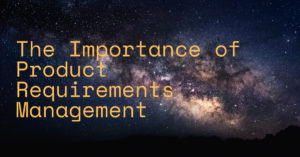Benefits of Requirements Management to Product Development
Requirements management is essential to product development, especially in the hardware development business. It is the process of defining, documenting, assessing, and maintaining a system’s set of requirements. The purpose of requirements management is to guarantee that the finished product fits the needs and expectations of all stakeholders, such as the product team, customers, and end users.
Adopting a requirements management tool such as Valispace is critical to the requirements management (and project management) process. Valispace is a cloud-based platform that enables the centralized administration of product requirements, allowing the product team to interact and exchange information more easily. It also enables requirement traceability, guaranteeing that the finished product fulfils all relevant criteria.
Requirements Collection and Documentation
Gathering and documenting requirements is the first stage in the requirements management process. This may be accomplished using various methods, including interviews, questionnaires, and focus groups. These strategies ensure that all stakeholders are included in the process and that their needs and expectations are met.
It is critical to distinguish between functional and non-functional requirements when documenting requirements. Non-functional requirements define how the product must work, whereas functional requirements describe what the product must perform. Valispace and other tools simplify writing and organizing requirements, making them available to the whole product team.
Prioritization and Management of Requirements
After gathering and documenting the criteria, the following step is to prioritize them. Techniques such as MoSCoW (Must have, Should have, Could have, Won’t have) and the Kano model can be utilized to prioritize requirements. This is significant because it helps the product team prioritize the most critical requirements, ensuring that the product is built quickly and efficiently.
Requirements will change as the development process advances. The product team must have a mechanism in place to manage these changes. This may be accomplished by holding regular meetings with stakeholders and utilizing a requirements management platform like Valispace, which enables easy tracking of changes.
Requirements for Verification and Validation
After gathering, documenting, and prioritizing the requirements, the following step is to check and validate them. Verification entails ensuring that the requirements are comprehensive and correct, whereas validation entails ensuring that the requirements fit the stakeholders’ needs and expectations. Inspections and walkthroughs are two methods for accomplishing this.
The product manager and other stakeholders are critical to the verification and validation process. They ensure that the specifications fit the end-user’s demands and that the final product is of good quality. Valispace, for example, enables seamless cooperation among stakeholders, making the verification and validation process more efficient.
Requirements Management Process Best Practices
Effective communication is critical to requirements management success. It is crucial that the product team understands the requirements and that stakeholders are kept up to date on any modifications. Valispace, a requirements management solution, makes it simple for the product team to share information and communicate, ensuring everyone is on the same page.
Managing requirements in an agile development environment can be challenging, but a flexible approach to requirements management is essential. Valispace, for example, enables easy tracking of changes and adaptation during the development process.
It might be tough to manage requirements in a remote team, but with a requirements management platform like Valispace, it becomes easy to interact and exchange information.
Learn how to properly break down requirements with this handy guide.
A precise and well-defined requirements management procedure is essential for large projects. This involves frequent stakeholder meetings, a well-defined system for documenting and organizing requirements, and a change management procedure. A solution like Valispace may be especially effective in managing big projects since it provides centralized requirement management and traceability, making it more straightforward for the product team to remain on top of the project’s development.
The product manager is responsible for ensuring that the finished product fulfils the demands of the stakeholders; hence they play an essential part in the requirements management process. Other team members, such as the development and QA teams, play vital roles in the process, and everyone should be informed of their duties. Furthermore, it is critical to have a clear grasp of each team member’s tasks and responsibilities.
Looking for the Best Requirements Management Software?
Valispace is not just any old requirements management tool.
It actually links requirements with engineering and technical data which means that when changes to the system have been made, requirements can be automatically verified and validated and any breach of requirement can be easily noticed and acted upon.
This means that unlike most requirements tools where the data is static, Valispace makes your requirements dynamic and does a lot of the heavy lifting.
See what this can do to your time, stress levels and overall project success by booking a call with us today.


